
There are many ways to block websites on Google Chrome. In fact, Chrome gives you the ability to block websites from within the browser, but it’s not the most intuitive way of doing it. You have to manually find and add each site you want to block in Chrome’s settings, which is a lot of work. In addition, if you’re trying to protect your kids from visiting inappropriate websites, they could simply use other browsers to circumvent these blocks.
For this reason, I always recommend using third-party tools to block websites in Chrome. If you’re looking to protect your kids online, you can’t go wrong with a good parental control app — it easily blocks inappropriate websites and includes additional protections, such as screen-time management tools and activity monitors. Plus, many parental control apps allow you to block other browsers, too.
Among the top parental control options available, Qustodio is my favorite. It lets you block websites and comes with web filters featuring over 25 predefined categories. During my tests, I was unable to bypass it with a VPN, which ensures that even tech-savvy kids can’t circumvent the safeguards in place. You can test it risk-free using its 30-day money-back guarantee.
However, if you’re looking to block websites for yourself, I have other suggestions, too. These suggestions work whether you’re looking to keep yourself safe from dangerous websites containing malware or simply trying to boost your productivity.
Other Ways to Block Websites on Google Chrome (Step-By-Step Guides)
There are alternative methods to block websites on Google Chrome other than using parental controls. Although not as comprehensive as parental control apps, these methods can be effective in enhancing your family’s online security and helping you become more productive.
Use a Reliable Antivirus App
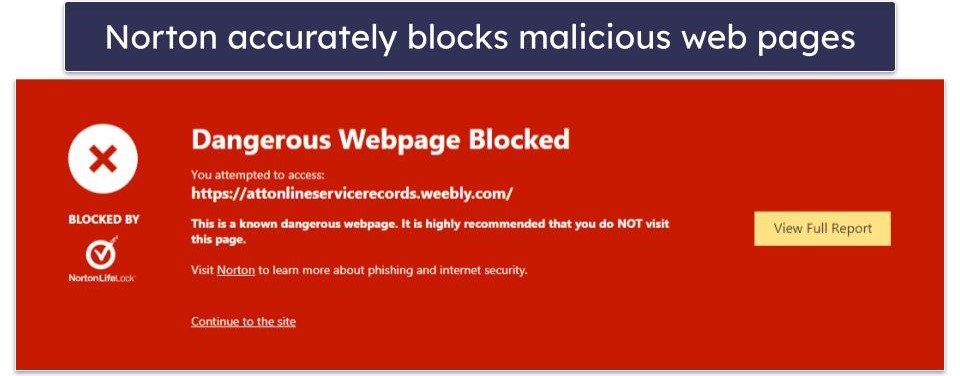
A reliable antivirus app is essential for blocking malicious websites that contain malware. A good antivirus, like Norton 360, will also help shield you from phishing attempts. Hackers are getting very sophisticated in creating emails and web pages that look like they’re coming from your bank or stores you shop at. A good antivirus will block these dangerous websites on Chrome.
Here’s how to block websites using a reliable antivirus app:
- Sign up for and create an account with a good antivirus. I recommend Norton because it has the most effective virus- and malware-blocking capabilities on the market.
- Download the software on your computer. On the antivirus’s homepage, click on Download then agree to the terms and conditions.
- Run the installer from your browser. This will install the antivirus on your computer. Be sure to copy the software key so you can download it on other computers if needed.
Your antivirus will now protect you from malicious websites. It’ll run in the background and alert you if you try to visit websites suspected of containing malware and viruses.
Use a Standalone Website Blocker

Standalone website blockers like Freedom are great for blocking distracting websites without the extras contained in a parental control app. For example, if you find yourself endlessly visiting social media, shopping, or blog sites, using a standalone website blocker will help you improve your productivity. All you have to do is select specific sites or categories of sites to block, and the blocker will stop you from giving in to temptation while it’s active. You can even schedule when the sites are blocked on Chrome, so you can automatically regain access to the sites after the work or school day is over.
Use Google Family Link
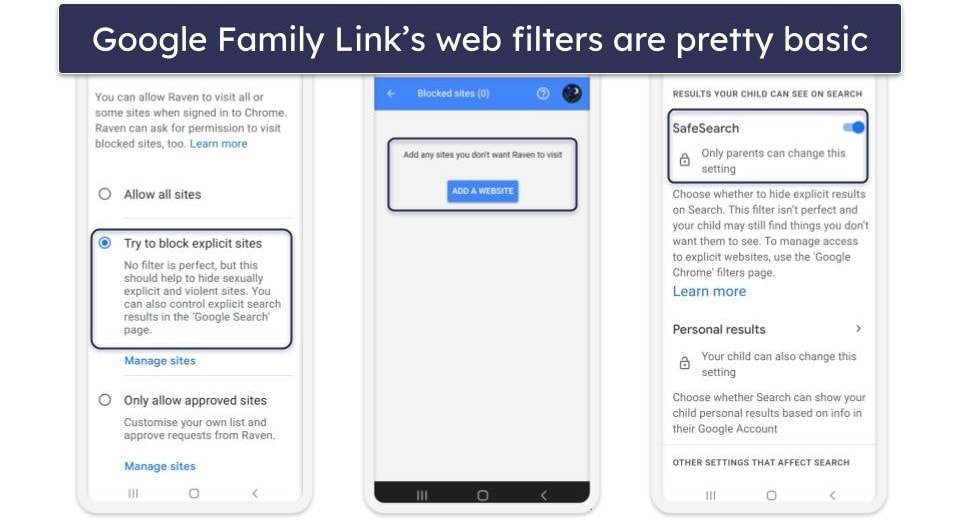
Google Family Link offers Google’s SafeSearch feature and the ability to block websites manually. However, its filtering options are somewhat limited compared to apps like Qustodio and
Here’s how to use Google Family Link:
- Set up Google Family Link. Start by installing the Google Family Link app on both your device and your child’s device.
- Add your child’s account. In the Family Link app, add your child’s Google account to your family group.
- Access Parental Controls. Using your own device, open the Family Link app and navigate to your child’s account. Here, you can access a range of parental control settings.
- Block websites. Within the parental control settings, select Filters on Google Chrome. You can now block specific websites by adding them to the blocked list.
Use Android’s Built-In Parental Control Settings
Using Android’s built-in parental control settings is a way to restrict website access on your child’s Android device. However, it’s not quite as feature-rich as an Android parental control app. It also won’t necessarily protect your kid’s device from malware or viruses — that’s why it’s also a good idea to install reliable antivirus software like Norton 360.
- Access Settings. On your child’s Android device, open the device settings.
- Tap on Digital Wellbeing & Parental Controls. Depending on the Android version, it might be called Digital Wellbeing & Parental Controls or simply Parental Controls.
- Set up parental control. Follow the on-screen instructions to set up parental controls.
- Create a PIN. You’ll be prompted to create a PIN or passcode to secure the parental control settings.
- Enable content filtering. Within the parental control settings, enable content filtering or web filtering.
- Add blocked websites. You’ll find an option to add specific websites to the blocked list. Enter the website URLs you want to block.
Use iOS’s Built-In Parental Control Settings
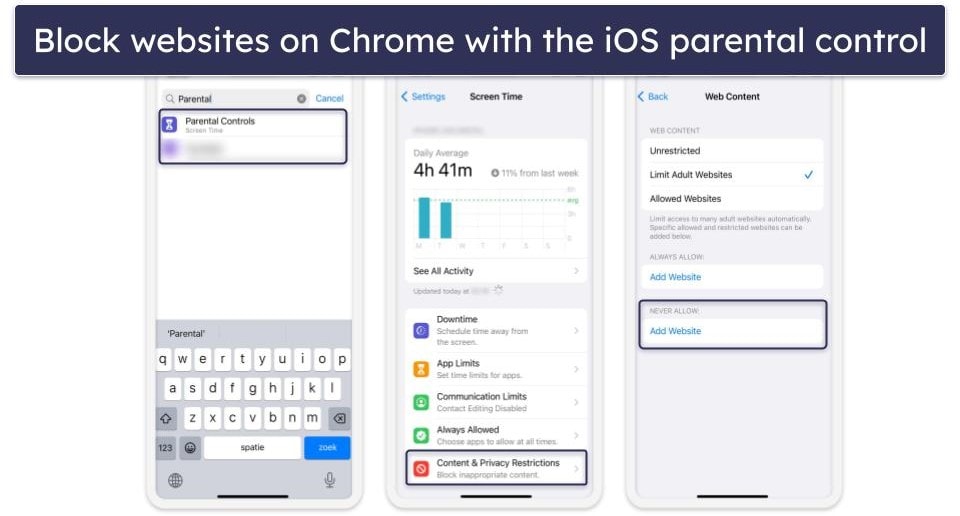
If your child’s iPhone has Chrome, it’s possible to restrict websites using the iOS Screen Time feature on your child’s iPhone, ensuring a safer online experience. However, it’s also worth checking out iOS parental control apps.
- Access Parental Controls. On your child’s iPhone, open the device settings and tap on Parental Controls. You’ll see a heading with Screen Time once you click on Parental Controls.
- Create a Screen Time passcode. You’ll be asked to create a Screen Time passcode to secure the parental control settings.
- Enable Content & Privacy Restrictions. Under Screen Time settings, tap Content & Privacy Restrictions and turn it on.
- Add blocked websites. In the Content & Privacy Restrictions section, find the Content Restrictions option. Tap Web Content and then choose Limit Adult Websites or Allowed Websites Only.
- Customize web restrictions. Add specific websites to the “Never Allow” list to block them (if you selected Limit Adult Websites). You can also allow only specific websites by entering them in the Allowed Websites Only section.
Use a Google Chrome Extension to Block Websites
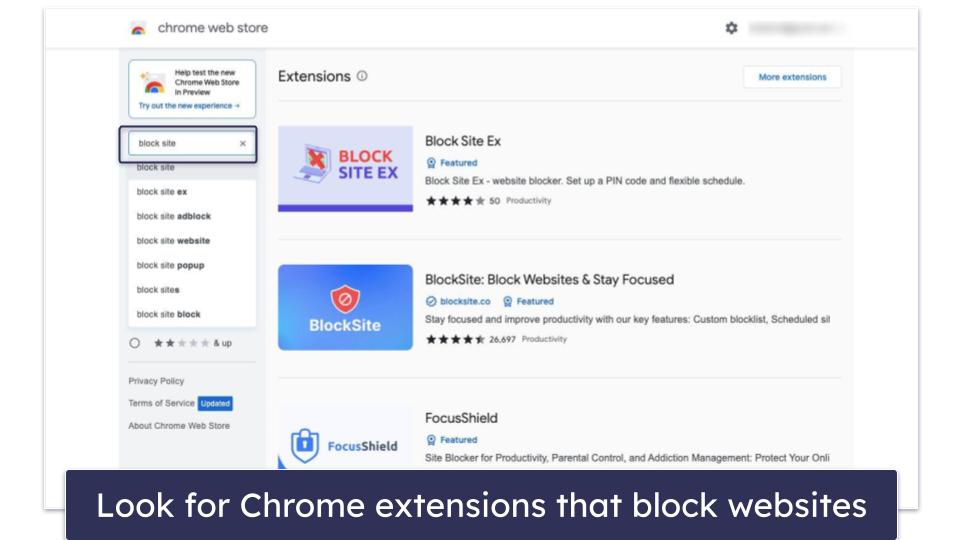
Using Chrome extensions to block websites is another way to restrict access to specific sites directly within the Chrome browser. This is very useful if you don’t want to be distracted by social media or game websites during working hours. With an extension, it’s easy to turn on and turn off website blocking, or to simply schedule when certain sites are blocked. Just don’t rely on an extension to protect your kids from inappropriate content — it’s easy for them to disable or remove any browser extension.
- Open Google Chrome. Launch the Google Chrome browser on your computer.
- Go to the Chrome Web Store. Click on the three dots in the upper-right corner of the Chrome window to open the menu. Choose Extensions and then select Open Chrome Web Store.
- Search for a site-blocking extension. In the Chrome Web Store, use the search bar to look for a site-blocking extension. Some popular options include BlockSite, StayFocusd, or Site Blocker.
- Select and install. Click on the extension you want to use, then click the Add to Chrome button. Confirm the installation when prompted.
- Add sites to block. In the extension settings, you’ll find an option to add websites to your blocked list. Enter the URLs of the sites you want to block.
- Set preferences. Customize the extension’s preferences, such as setting the duration of blocks, enabling password protection, or scheduling blocking times.
- Save settings. Save your settings, and the extension will now block the specified websites when you or your child tries to access them in Google Chrome.
Using Google SafeSearch Filters
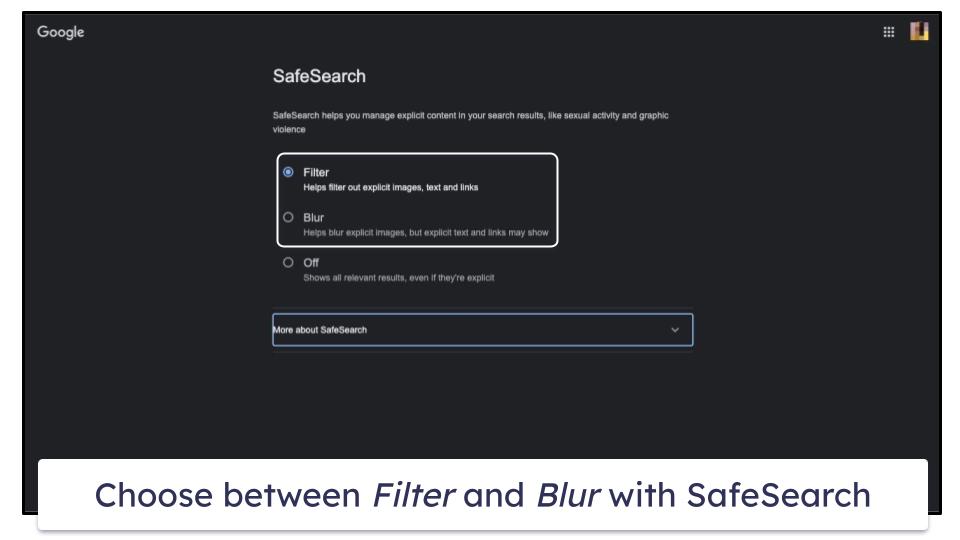
Google’s built-in SafeSearch feature is a good way to filter out search results you don’t want your family to see. It’s not perfect, but it does a pretty good job of filtering out results with explicit or violent content. It also helps the Google algorithm to learn your search preferences, so you and your kids are less likely to see unwanted search results as time goes on.
- Sign into your child’s Google account. Use your child’s login credentials for Google to sign in. If your child is under 18 (and filled in the correct age on their Google account), Google will automatically enable SafeSearch.
- Visit the Google homepage. Type “google.com” in the search bar.
- Open Search Settings. Locate the Settings button in the bottom-right corner and select Search settings.
- Turn SafeSearch on. Scroll down to SafeSearch and turn it on. You can choose to filter websites or to blur explicit images only.
Router-Level Website Blocking
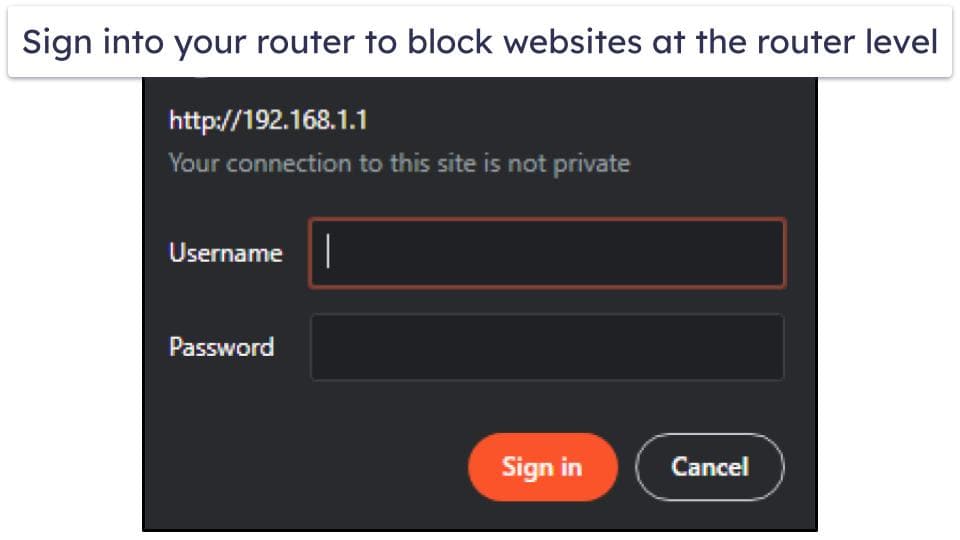
Using a router-level block is a good way to completely block websites on your Wi-Fi network and cover all browsers — but be aware — if your kid has a mobile data plan they can simply switch to that, circumventing your router entirely. This method is best employed by adults looking to avoid distracting websites.
- Access router settings. Open a web browser and enter your router’s IP address in the address bar. Typically, this is something like “192.168.1.1” or “192.168.0.1.” Log into your router using your admin credentials.
- Locate parental control or website blocking. Navigate through your router’s settings to find the parental control or website blocking section.
- Add websites to block. In the parental control or website blocking section, you can usually add specific websites to a blocklist. Enter the URLs of the websites you want to block. Since this is done at the router level, it should apply to all web browsers.
- Save settings. Save your changes, and your router will now block access to the specified websites for all devices connected to your network.
Chrome Enterprise Admin Controls
This last option isn’t the most accessible, but it’s helpful for those running a business wanting to block websites on their endpoints. I don’t recommend it for parents or those looking to increase their productivity, but here’s what you have to do:
- Access Google Admin Console. If you are an administrator of a Chrome Enterprise environment, log into the Google Admin Console.
- Navigate to Device Management. In the Admin Console, go to Device Management or Chrome Management, depending on the version.
- Configure URL blocking. Under device settings or policies, look for the option to configure URL blocking or content filtering.
- Add websites to block. Enter the URLs of the websites you want to block in the URL blocking section.
- Apply policies. Apply the policies to the Chrome devices in your enterprise network. The specified websites will be blocked for all managed Chrome browsers.
Why Should I Use a Parental Control App to Block Websites on Google Chrome?
Parental control apps offer a comprehensive solution to ensure online safety for your family. They not only allow you to block websites with content inappropriate for kids, but they can help protect your devices from sites known to contain malware.
The apps also allow you to monitor online activities and enforce web filters, creating a more secure digital environment for everybody. My favorite parental control app is Qustodio, as I couldn’t use even a VPN to bypass any of the website blocks during my tests.
Quick summary of the best parental control apps for blocking websites on Google Chrome:
🥇 1. Qustodio — Best parental controls for blocking unsuitable sites on Google Chrome.
🥈 2. Norton Family — Great web filtering tools to block inappropriate content on Chrome.
🥉 3. Bark — User-friendly app for blocking different sites at different times.
Frequently Asked Questions
Can I block specific websites without using a parental control app?
Yes, you can manually block websites in Chrome’s settings but parental control apps are better — they provide a more convenient and versatile way to manage website restrictions. Many allow you to block other browsers, have predefined web filtering categories, and will send you alerts if your child tries to access blocked websites.
Can I block websites on Google Chrome using a free parental control app?
Some free parental control apps offer basic website blocking features, but for comprehensive control and advanced features, you might consider investing in a premium app like Qustodio. These apps come with advanced web filters, allow you to block websites and apps manually, and often give insights into your child’s browser history.
Free parental controls typically offer limited features and capabilities compared to their premium counterparts. Additionally, they may come with annoying ads or privacy concerns, as some free apps collect and share user data.
Can I schedule Chrome blocks for specific times, like during work or study hours?
Yes, parental control apps often include scheduling features that allow you to set specific times for app blocks, helping to ensure that you and your kids aren’t distracted during work or study hours.
Qustodio even allows you to schedule internet blocks, preventing your kids from browsing online during specific times. For instance, I enabled Chrome blocks between 5pm and 7pm as I wanted to ensure that my kids would do their homework during that time.
What if I want to unblock a website temporarily for a specific purpose?
Most parental control apps offer flexibility, allowing you to temporarily unblock websites when needed, and then reapply restrictions. For example, during your kid’s study hours, you might want to block distracting social media sites but make wikipedia.org available for a research project. Then when the project is finished, you can easily unblock the social media sites. Qustodio allows you to simply delete the website from the blocklist and add it again whenever you want.